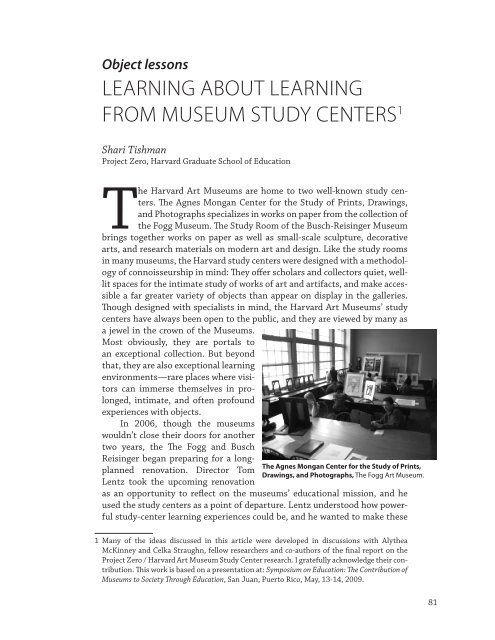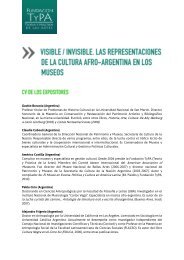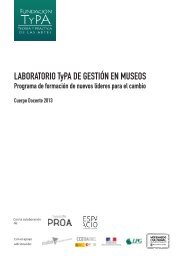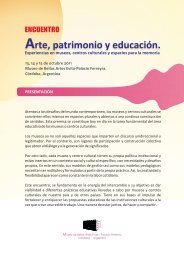La aportación educativa de Los museos a La ... - Fundación Typa
La aportación educativa de Los museos a La ... - Fundación Typa
La aportación educativa de Los museos a La ... - Fundación Typa
Create successful ePaper yourself
Turn your PDF publications into a flip-book with our unique Google optimized e-Paper software.
the educative contribution of museums to society<br />
Object lessons<br />
LEARNING ABouT LEARNING<br />
fRoM MuSEuM STuDy CENTERS 1<br />
Shari Tishman<br />
Project Zero, Harvard Graduate School of Education<br />
The Harvard Art Museums are home to two well-known study centers.<br />
The Agnes Mongan Center for the Study of Prints, Drawings,<br />
and Photographs specializes in works on paper from the collection of<br />
the Fogg Museum. The Study Room of the Busch-Reisinger Museum<br />
brings together works on paper as well as small-scale sculpture, <strong>de</strong>corative<br />
arts, and research materials on mo<strong>de</strong>rn art and <strong>de</strong>sign. Like the study rooms<br />
in many museums, the Harvard study centers were <strong>de</strong>signed with a methodology<br />
of connoisseurship in mind: They offer scholars and collectors quiet, welllit<br />
spaces for the intimate study of works of art and artifacts, and make accessible<br />
a far greater variety of objects than appear on display in the galleries.<br />
Though <strong>de</strong>signed with specialists in mind, the Harvard Art Museums’ study<br />
centers have always been open to the public, and they are viewed by many as<br />
a jewel in the crown of the Museums.<br />
Most obviously, they are portals to<br />
an exceptional collection. But beyond<br />
that, they are also exceptional learning<br />
environments—rare places where visitors<br />
can immerse themselves in prolonged,<br />
intimate, and often profound<br />
experiences with objects.<br />
In 2006, though the museums<br />
wouldn’t close their doors for another<br />
two years, the The Fogg and Busch<br />
Reisinger began preparing for a longplanned<br />
renovation. Director Tom<br />
Lentz took the upcoming renovation<br />
as an opportunity to reflect on the museums’ educational mission, and he<br />
used the study centers as a point of <strong>de</strong>parture. Lentz un<strong>de</strong>rstood how powerful<br />
study-center learning experiences could be, and he wanted to make these<br />
The Agnes Mongan Center for the Study of Prints,<br />
Drawings, and Photographs, the fogg art museum.<br />
1 Many of the i<strong>de</strong>as discussed in this article were <strong>de</strong>veloped in discussions with Alythea<br />
McKinney and Celka Straughn, fellow researchers and co-authors of the final report on the<br />
Project Zero / Harvard Art Museum Study Center research. I gratefully acknowledge their contribution.<br />
This work is based on a presentation at: Symposium on Education: The Contribution of<br />
Museums to Society Through Education, San Juan, Puerto Rico, May, 13-14, 2009.<br />
81






